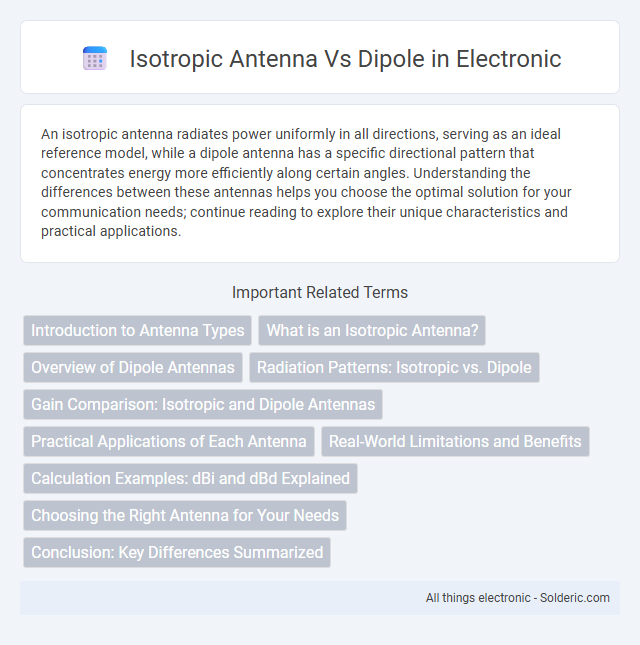An isotropic antenna radiates power uniformly in all directions, serving as an ideal reference model, while a dipole antenna has a specific directional pattern that concentrates energy more efficiently along certain angles. Understanding the differences between these antennas helps you choose the optimal solution for your communication needs; continue reading to explore their unique characteristics and practical applications.
Comparison Table
| Feature | Isotropic Antenna | Dipole Antenna |
|---|---|---|
| Definition | Hypothetical antenna radiating equally in all directions | Real antenna with two conductive elements, radiates primarily perpendicular to its axis |
| Radiation Pattern | Uniform spherical radiation pattern (omnidirectional) | Figure-eight in the plane perpendicular to the antenna |
| Gain | 0 dBi (reference standard) | Approx. 2.15 dBi |
| Practicality | Theoretical model, not physically realizable | Commonly used, physically realizable antenna |
| Use Case | Reference for antenna gain and performance comparison | Broadcasting, communication systems, and measurement applications |
| Polarization | Undefined (theoretical) | Linear polarization |
Introduction to Antenna Types
Isotropic antennas emit electromagnetic waves uniformly in all directions, serving as a theoretical reference model for antenna performance. Dipole antennas, commonly used in practical applications, provide directional radiation patterns with higher gain along their axis, enhancing signal strength in specific directions. Understanding the differences between isotropic and dipole antennas helps you choose the optimal antenna type for efficient wireless communication and signal coverage.
What is an Isotropic Antenna?
An isotropic antenna is a theoretical point source that radiates electromagnetic waves uniformly in all directions with equal intensity, serving as a reference model in antenna theory. Unlike a dipole antenna, which has a specific directional radiation pattern and gains typically around 2.15 dBi, the isotropic antenna has a gain of 0 dBi by definition. This idealized antenna is used as a baseline for measuring and comparing real antenna performance, helping engineers evaluate directional gain and efficiency.
Overview of Dipole Antennas
Dipole antennas consist of two conductive elements such as metal rods or wires, typically half a wavelength long, that radiate radio frequency energy. Unlike isotropic antennas which are theoretical models radiating power uniformly in all directions, dipole antennas exhibit directional patterns with maximum radiation perpendicular to the antenna axis. Commonly used in wireless communications, dipole antennas offer practical gain and versatility for transmitting and receiving signals in specific spatial orientations.
Radiation Patterns: Isotropic vs. Dipole
An isotropic antenna radiates power uniformly in all directions, creating a perfect spherical radiation pattern ideal for theoretical modeling. In contrast, a dipole antenna exhibits a toroidal radiation pattern with maximum radiation perpendicular to the antenna axis and nulls along the axis. The dipole's directional pattern provides gain and improves signal strength in specific directions, unlike the omnidirectional isotropic model.
Gain Comparison: Isotropic and Dipole Antennas
Isotropic antennas have a theoretical gain of 0 dBi, representing an ideal point source radiating equally in all directions, while dipole antennas typically exhibit a gain around 2.15 dBi, offering directional advantage in the horizontal plane. The higher gain of dipole antennas means Your signal strength and communication range improve in preferred directions compared to isotropic radiators. Understanding this gain difference is critical for optimizing antenna selection in wireless communication systems.
Practical Applications of Each Antenna
Isotropic antennas serve as theoretical reference models in antenna design, offering uniform radiation in all directions, which makes them ideal for benchmarking performance and calibrating antenna systems. Dipole antennas, widely used in practical applications such as radio broadcasting, television transmission, and wireless communication, provide directional radiation patterns that enhance signal strength and coverage in specific areas. Your choice between isotropic and dipole antennas depends on whether you require idealized measurements or effective signal transmission within targeted environments.
Real-World Limitations and Benefits
Isotropic antennas, idealized as perfect point sources radiating uniformly in all directions, do not exist in practical applications due to physical and material constraints, making dipole antennas the more common choice with directional radiation patterns that provide better gain and efficiency. Dipole antennas offer real-world benefits such as improved signal strength and range in specific directions, making them suitable for targeted communication and reception. However, their directional nature introduces limitations in coverage uniformity compared to the theoretical isotropic model, requiring careful orientation in deployment scenarios.
Calculation Examples: dBi and dBd Explained
Isotropic antennas serve as ideal reference points with 0 dBi gain, enabling the calculation of real antenna gains by comparison. Dipole antennas typically have a gain of about 2.15 dBi, which corresponds to 0 dBd, representing gain relative to a dipole. Converting gain values between dBi and dBd involves adding or subtracting 2.15, allowing precise performance evaluation in antenna design.
Choosing the Right Antenna for Your Needs
Choosing the right antenna depends on your specific communication goals and environment. An isotropic antenna provides an idealized, uniform radiation pattern used mainly as a reference for measuring antenna gain, while a dipole antenna offers a practical, directional radiation pattern with higher gain and improved signal strength in targeted directions. Understanding the trade-offs between isotropic ideality and dipole efficiency helps you optimize your antenna setup for maximum performance in your application.
Conclusion: Key Differences Summarized
An isotropic antenna radiates power uniformly in all directions, serving as an idealized reference model with no physical structure, while a dipole antenna exhibits a directional radiation pattern with lobes and nulls due to its physical length and orientation. Dipole antennas provide gain in specific directions, typically around 2.15 dBi over an isotropic source, enhancing signal strength and reception efficiency. The key difference lies in isotropic antennas being theoretical benchmarks for antenna gain measurement, whereas dipoles are practical antennas widely used in communication systems for targeted signal transmission and reception.
isotropic antenna vs dipole Infographic

 solderic.com
solderic.com